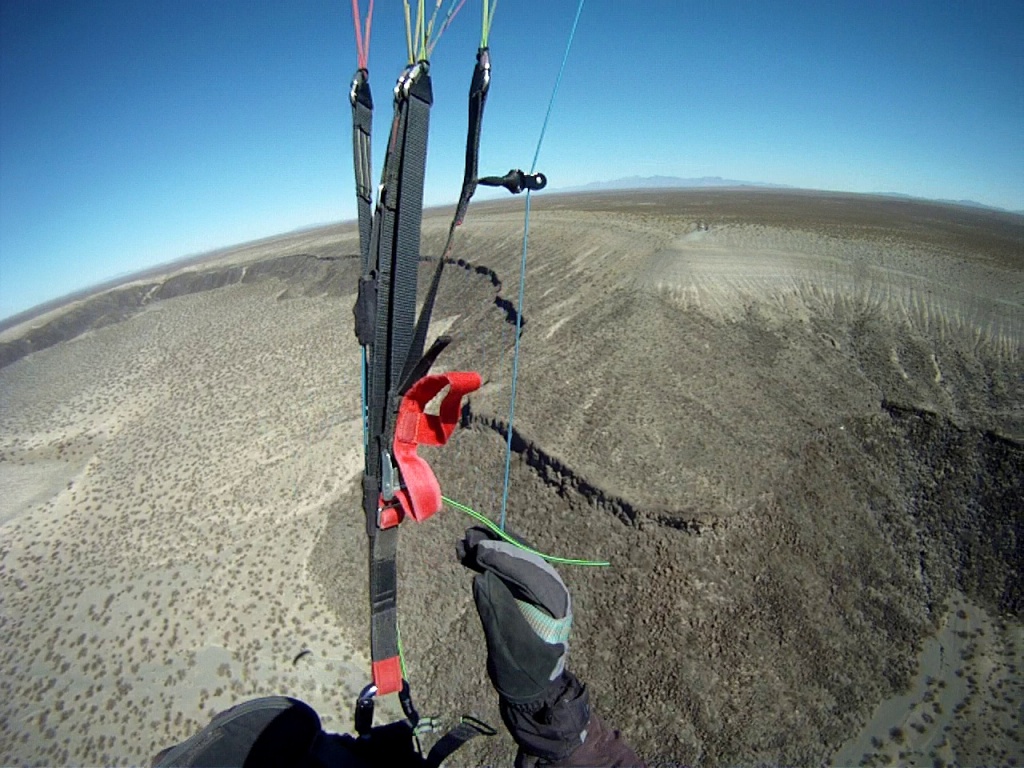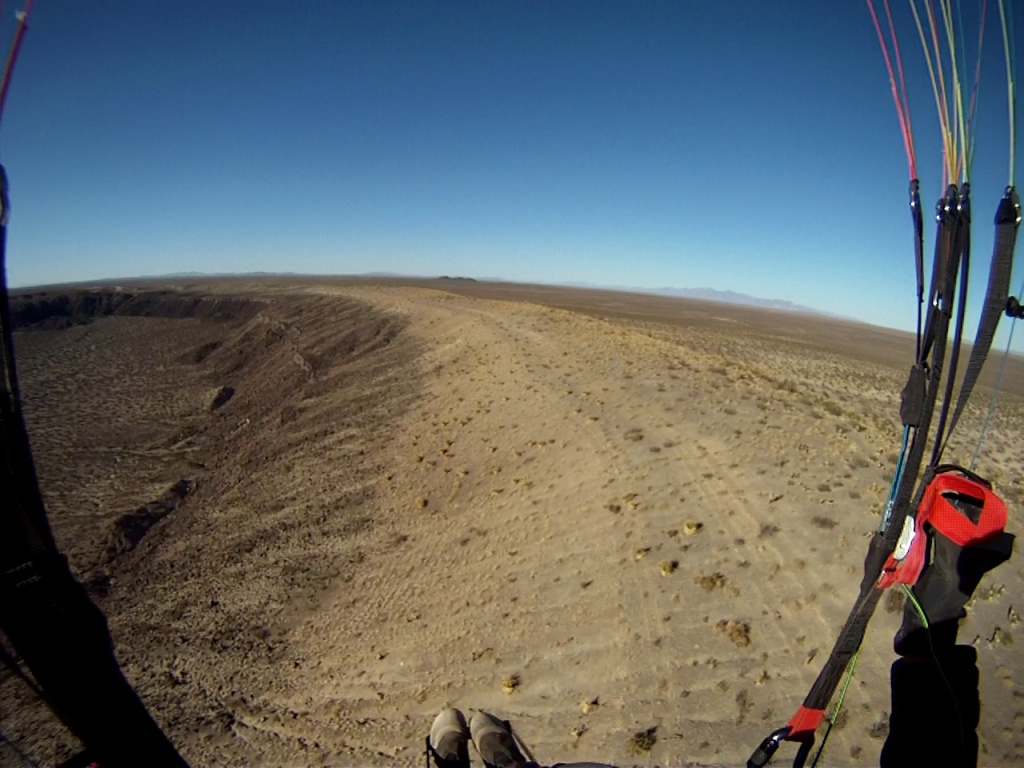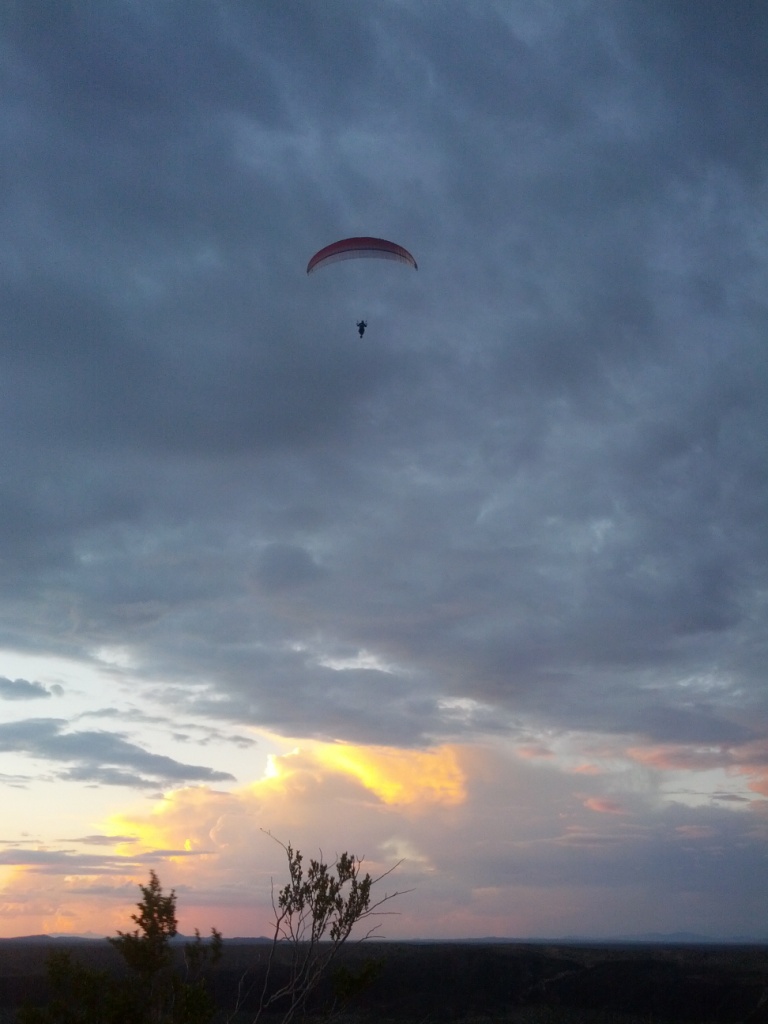Kilbourne Hole maar
NOTE: SOME OF THE INFORMATION HERE MAY NOT BE CURRENT. PLEASE GO TO THE RIO GRANDE SOARING ASSOCIATION SITE GUIDE FOR THE MOST CURRENT INFORMATION.
Doña Ana County, New Mexico
East Launch 31.968833° -106.953967°,
4,360 MSL 440' AGL (main LZ) directions
Main LZ 31.971866° -106.963756°
Suggested rating requirements for East Launch: H/P3. All other launch areas are H/P4 because of hazards!
Notice: Most of the bottom of Kilbourne Hole maar is New Mexico State Trust Land. According to their website, we would need a recreational permit to voluntarily be on that land. However, pilots who land there, have to. They were unable to land anywhere else, like at the top of the rim, and had to find a safe LZ somewhere else i.e. the bottom of the maar. That is, it is an emergency landing. Southwest Airsports is not a law firm but it is reasonable to assume that if a pilot finds himself at the bottom of the maar, he is probably OK, being there without a permit. No one would land at the bottom unless he has to. That is safe to assume.
USHPA required notification: The RGSA recommends that you do not fly at this site as it is not a chapter managed site. If you do choose to fly at this site, you must take full responsibility for your actions, and recognize that you are fully and solely liable for any damage incurred by yourself, to others, or to others’ property. This site is unimproved with significant safety issues, including potentially challenging wind and thermal conditions. Flying at this site can be risky to the pilot, property owners, and our sport as a whole. This site is unpermitted, uninsured, unmanaged, and unimproved. This site is, however, an insured training site for Southwest Airsports and is used by its students.
Introduction
This is the only soarable maar in the world for ultralights. As of 2019, less than 25 pilots have ever soared it, largely because of its remote location. This site was developed and first flown by Had Robinson for paragliding. Robin Hastings was the first hang gliding pilot to fly this site and helped develop it for hang gliding.
The maar is located within the Organ Mountains - Desert Peaks National Monument (the rim). The bottom of the maar is New Mexico State Trust Land which requires a permit in order to trespass.
Soaring a maar is unusual because it can be flown with winds from various directions. A pilot can soar around the rim and find the "sweet spot" for that particular wind direction. However, this maar is a highly thermic site because of the abundance of black basalt around the rim. If a pilot wants to only ridge soar, the best times are early/late in the day or when it is overcast. If the winds are too high at launch, wait until 15-30 minutes before sunset and then launch. After sunset, the winds almost always die off near the surface. However, if a pilot launches at sunset and gets a few hundred feet high, he will be in the winds aloft and not be affected by the inversion and can soar until it is too dark to see.
The black basalt gets intensely hot and generates powerful thermals which, during the heat of the day, block the winds making soaring difficult, to say nothing of excessive turbulence. The bottom of the maar has lighter or non-existent winds so the LZ is always a safe bailout in case high winds are encountered at the rim. However, getting blown over the back of the rim is not an issue except that a pilot may get his glider in the bushes. The LZ is a huge (1/4 mile on each side) grassy/weed area that is free of obstacles. Please keep an eye out for the occasional drain holes (6" in diameter or so) that go from the surface to the lava dome deep in the earth. This is why the bottom of the maar never fills with water.
First time pilots should have a guide if they are not experienced P3's with mountain launch skills.
This site has some cell service at the top of the rim. If a pilot lands at the bottom of the maar communication with the outside world is only possible with a satellite telephone/communicator. For this reason it is hazardous to fly this site alone. Kilbourne is remote and is a "dark sky" site (no electric lights). Camping in the area is permitted.
Kilbourne Hole is one of just a few places in the world where the mineral Green Peridot (an olivine crystal) can be found on the surface of the earth. However, the mineral found here is not of particularly good quality due to the very rapid cooling of the maar's material after its eruption.
Thermalling above Kilbourne Hole maar. View is northeast. The black basalt cliffs are the source for the intense thermals at the maar. The pilot here first got up with ridge lift and then found a thermal out front to get even higher. East Launch is the point on the rim just to the right of the glider's risers.

Expectations for student pilots
Students must be rated P1 and enrolled in the P2 training course. After the completion of at least (15) training flights under tow at the turf farms, a student may fly Kilbourne.
Wind must be 230º. Wind speed should be at least 4 mph and not greater than 10 mph. The site is not soarable with winds less than 7 mph.
The site should not be flown outside of the normal 1.5 hours on either side of dusk and dawn because of the intense thermals that drift in from desert out front.
Forward or reverse launches may be done safely at Kilbourne Hole.
The first launch at Kilbourne should always be a "sledder" to the bottom of the maar. It is an easy glide to the main LZ. The only modest hazard for new pilots is to avoid the bushes that surround the huge grassy LZ.
Subsequent launches by students: After launching and the winds are 7 mph or greater, the student pilot may turn right and attempt to soar the rim of the maar that goes north for about 1/4 mile. AT ANY TIME HE FINDS HIMSELF BELOW LAUNCH HE MUST IMMEDIATELY TURN AND GO STRAIGHT OUT AND LAND IN THE MAIN LZ.
If a student gets higher than launch, a top landing is easy and safe anywhere along the top of the rim. Because of the maar's geography, "going over the back" is a safe alternative to the main LZ (which requires a 40 minute hike back to launch). The only hazard of going over the back of the rim is the presence of a fence line approximately 100 yd. south of the main launch that runs east and perpendicular to the rim for about 1/4 mile. If a pilot was going over the back, he would have to turn right and go hundreds of yards before he would be in the area of the fence. No pilot would be soaring the rim south (to the left) of launch, anyway.
Site Guide
LZ
The LZ is a 1/4 mile in diameter, flat, and without significant obstacles. It's a 30 minute drive to the bottom on a rough and steep road (4 wheel drive only with low pressure tires). Pilots can always hike back to launch with their gear which takes about 45 minutes. Note there is one spot when climbing up the only easily available crack in the basalt cliff where one could slip and fall about 10' and experience serious injury. It is advisable to wear your helmet when moving through this area and proceed with extreme caution. ALWAYS FLY WITH A PACK BAG IN CASE YOU ARE FORCED TO LAND AT THE BOTTOM AND HAVE TO HIKE OUT!
Launch areas
There are an infinite number of launch sites at Kilbourne because of the inherent geography of a maar. However, pilots launch from a very limited number sites because of the prevailing wind direction and better safety and ease of launch. Pilots should stay just in front of the rim which is the area of maximum lift if altitude is less than 100' AGL.
If winds are less than 7-8 mph, plan on doing a sled ride as there is not enough lift to keep a pilot up.
Winds of 14+ will take the pilot to at least 200' over launch. Once a pilot gets 200'+ AGL, the lift zone gets much wider, laminar, and more consistent. It is thrilling to soar a maar as a pilot can safely explore the limits of the lift in either direction. If you do this, however, be prepared to top land at any time.
Top landing is easy anywhere around the rim as it is clear of obstacles and rotor due to the topography of a maar.
East Launch
The East Launch (photos below) is the best because:
- It is the
highest part of the rim with the correct topography to give the most lift.
- The prevailing winds are
from the southwest which gives this launch the advantage.
- It works well with winds from the southwest to the northwest.
- Launch from the northerly part of the launch area.
- Always turn to the right and work the northerly 1/2 mile of the rim. Once you are 150' or so above launch, you can explore the rim as far as you can find lift, including flying south of launch.
It can even be flown with winds from the south but the soaring range is only about 75 yd. – a good challenge as the pilot must be constantly turning back and fourth. It is better to use the northwest launch if winds are south southeast to southeast.
The east launch can be easily flown by H/P2's as it is the closest to the LZ and an easy and safe sled ride.
Pilots should turn to the right after launching as it puts the LZ closer in case conditions are not optimal. East Launch is a point sticking out into the maar. The rim south of the launch quickly drops down in altitude which makes it harder to soar in lighter winds. Other launch sites around the rim (depending on wind direction) require advanced skills, especially spot/side hill landing expertise, and are rated H/P3. A cliff launch rating would be highly advisable.
East Launch is about a mile in the distance. Note that it is a somewhat overcast day. When the sun is out, abundant thermal blocking of the winds at launch occur and it is harder to soar but easy to catch thermals.
View of the LZ (light area) from East Launch. It is a 1/4 mile in diameter, flat, and easy to land it.
View is from the easterly bottom of the maar.
East Launch. Winds were strong that day and everyone got up!
Wind direction
Southwest winds (prime direction)
When winds are southwest it is the best. This is because the higher parts of the rim are located in the northerly half of the maar. As SW winds advance towards the maar, they flow down a broad canyon that is located southwest of the East Launch. The winds fill the maar and are pushed towards its northerly rim. This generates the maximum and turbulent free lift we experience under these conditions.
West to northwest winds
Soaring is possible with winds from the west or northwest. Lift is about half of what it would be with southwest winds because the air that spills into the maar mostly exits the southerly rim which is much lower. As a result, less air is forced up and over the northerly section of the rim. The air is also more turbulent because it spills over the higher parts of the rim and tumbles down into the center of the maar. The air is in a disturbed state when it reaches East Launch.
Northwest to east winds
Soaring is difficult or impossible because of the lower elevation of the maar's southerly rim and, most importantly, lack of a obstacle free LZ within an easy glide of the rim.
Southeast to SSW winds
Soaring is difficult or impossible because the north to northeast parts of the rim are wide with a shallow slope and, accordingly, the lift is weak or non-existent. Furthermore, if winds quickly die down, as they do near dusk, a pilot will be forced to land in a boulder strewn area below launch because the bottom of the maar is too far away to safely glide to. However, it is possible to soar the short face of East Launch that faces south.
Hazards
Kilbourne Hole has one dangerous hazard: If you get lower than launch at any time, head immediately towards the LZ (the bottom of the maar) or top land immediately. PILOTS MUST NOT ATTEMPT TO LAND BETWEEN THE TOP OF THE RIM AND THE TOP OF THE BASALT CLIFF!
This is a serious and potentially deadly hazard because the area is strewn with huge boulders and small ravines. It is also very steep. This is to say nothing of landing near or at the top of the cliff, rolling down the incline, and then falling over the cliff. Nonetheless, it is possible to soar the face of the basalt cliff if the winds are sufficient. This would only happen if a pilot flies too far out in front of the rim and out of lift generated by the rim and does not want to head to the LZ. will not be desirable if a pilot gets 100' over launch and then, because of weakening winds, begins to sink out. Unless you want to hike out of the maar, top land immediately.
Southwest of East Launch, about 50' below, is a small canyon and hill that is behind the basalt cliff. If a pilot is ridge soaring the southwest face of East Launch in weak conditions and drops below launch, he should stay clear of this area. There is significant rotor behind the small hill at the base of launch and he will quickly sink out. In high wind conditions, the rotor is dangerous. Side hill landing, however, behind the canyon and at the base of launch is possible but there are boulders close by. Landing in this area requires advanced skills. A better and safer place to side hill land is more south of launch. A side hill landing in this area is easy and much safer. It is important for the pilot to always be aware of weakening conditions and be prepared to immediately side hill land or go to the LZ.
Always be sure to put your pack bag in your harness. You cannot safely hike out of the maar carrying a loose glider. You must have both hands free to safely climb up the basalt cliff.
If you fly near dusk, carry a headlamp so you can see your way, especially through the crack in the basalt cliff that is near the base of East Launch.
Flying along the northeasterly section of the rim. Winds were WSW at around 12 mph. East launch is behind the pilot.

Below, soaring high above the east rim of the maar. The LZ is just visible to the left.
Soaring 600' over – a record for this maar. Launch is directly below. The winds this day were southwest at 15 -18 mph at launch. View is south. No one is yet sure how this altitude was reached but was probably a combination of a huge thermal generated in front of launch and ridge lift. No one has yet gone XC from Kilbourne Hole maar.
Northwest launch looking southwest. Robin Hastings is just getting ready to launch his hang glider – he is the first to fly a hang glider at the maar.
Brad Gray enjoying dusk at the maar out in front of the east launch – it's a magic time.

![]()




